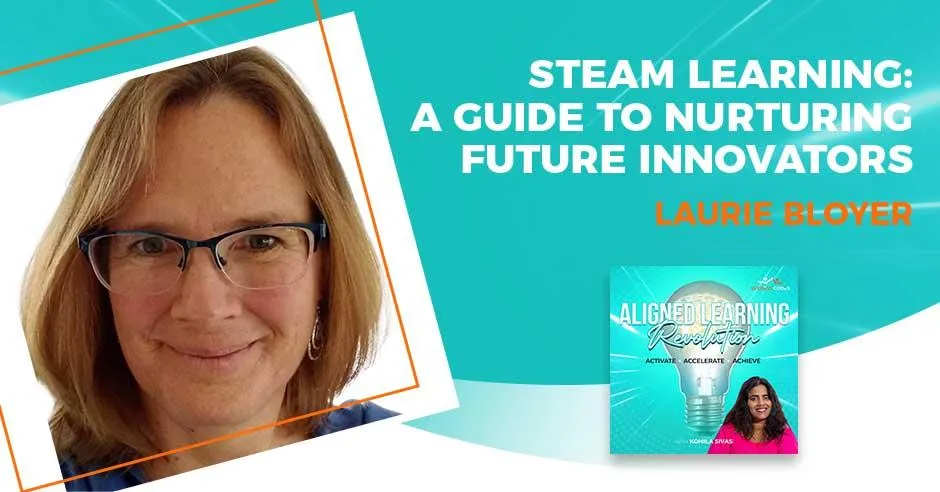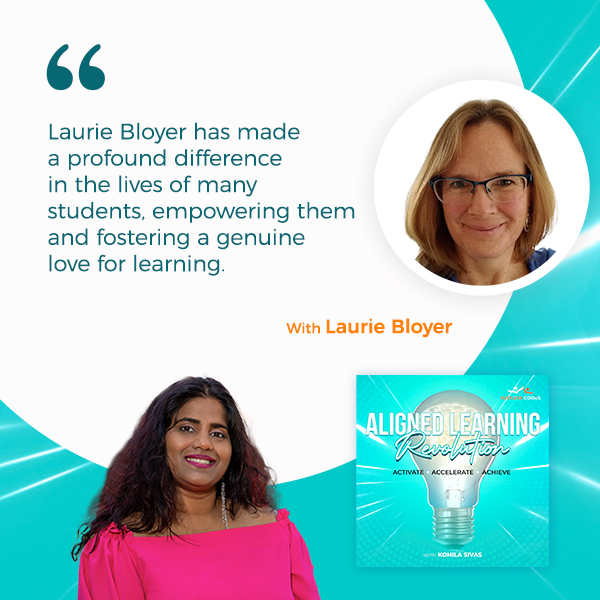Our Blogs
Education is constantly evolving, and our blog keeps you in the loop. Stay informed about innovative coaching methods, emerging technologies, and educational trends that shape the future of learning. Learn about our revolutionary Wholistic NeuroGrowth Learning Success Coaching.

STEAM Learning: A Guide To Nurturing Future Innovators With Laurie Bloyer
STEAM learning plays a vital role in nurturing future innovators by providing a well-rounded and dynamic educational experience. As parents and educators, we need to encourage students to find a love for learning. In this episode, Kohila Sivas interviews Laurie Bloyer, a Wholistic Learning Success Coach and the founder of Nexus Success Coaching. With a passion for helping students learn how to learn, Laurie shares to us the value of STEAM learning and how parents can support their children at home. She tackles the challenges in the current educational landscape, the need for personalized learning, and the importance of soft skills, hands-on learning, and project-based approaches in education. Laurie also touches on the impact of technology, sharing insights on finding a balance and setting boundaries, especially for children with dyslexia and anxiety. This episode serves as a guiding beacon for parents seeking to actively support their children's educational journey through wholistic and effective approaches. Tune in!
---
Watch the episode here
Listen to the podcast here
STEAM Learning: A Guide To Nurturing Future Innovators With Laurie Bloyer
I have the pleasure to introduce our holistic neuro-growth learning success coach Laurie Bloyer, an esteemed educator with over two decades of experience. She has positively impacted the lives of more than 1,500 students, including her own anxious and dyslexic child. Armed with a master's degree in Instructional Design and Technology, as well as in Waldorf education.
Laurie's passion lies in empowering students and nurturing their love for learning specializing in STEAM, reading, writing, English as a second language, design thinking skills, and life skills. Laurie's rich subject matter expertise ensures a comprehensive and insightful educational experience. Her dedication to personalized learning is evident through the development of proven strategies tailored to individual needs, fostering the growth of effective and independent learners. Let's welcome Laurie.

Laurie, welcome to our show. How are you?
I'm good. How are you, Kohila?
Very good. Tell me that you've been a teacher for several years.
Sorry to lose count, but several years.
Thank you for your service.
Thank you.
We have to celebrate teachers. It's important. As any other service teacher, we give a lot. I've met so many teachers like 45 years.
That is amazing.
Teaching In Today’s School System
No amount of patience a teacher has to go through to be 45 years of service because teaching is all about patience. Tell me how is teaching for you now in the school system? How is it going?
It's a challenge. I've taught in different types of schools in different formats and every age possible. It's getting harder. The kids that I teach don't seem to be as respectful as I remember them many years ago. I think parents are tired and they don't communicate as much and expect a lot more. It almost feels as if children have been given so many freedoms at home or maybe it's because of the post-COVID, but they just aren't being held as accountable as certainly I was when I was a kid or as the kids that I used to teach years ago. That's one aspect of it.
You nailed it. I like that the word you said, “That's what it is.” We're not keeping accountable for the student. It's beautiful. I didn't recognize the word associated with that.
The other thing that frustrates me and I know my colleagues for sure is the amount of paperwork that we have to do to prove that we are good teachers is a bizarre twist. We're teaching but the observations, the paperwork and to prove that we are good at what we do is challenging to teach your students. It takes away from our lesson planning and the relationships we'd like to build with our administrators or with the students in the classroom. That makes it hard. We are good teachers, but because we have so many baskets we have to fill, it completely drains us. That's why I'm having a hard time in the classroom now.
It's important that we talk about this because if I'm a parent, I only have the perspective of what I see from my end, “I'm sending my child to school. Teachers are not doing enough because he's still failing or he's not interested and lacks motivation.” If I look at it from the child's mind, “I don't see what's the point of doing all this.” Everybody has their own lenses they're looking through.
This show is all about looking from other people's perspectives so we can all come together because that's the only way to bring this in alignment to serve our students, our kids. Kids are the most precious person in this equation. Out of all of these people, they need to be protected. I love that accountability. How do you think we can bring back accountability in our students?
The way I try to do it is by, as you said, giving them more real-world experiences and experiences that help them feel more accountable. Experiences that, for example, time management. Being in control of their time management rather than someone controlling it for them and them when they do it. Seeing that success, I'm being like, “I got this. I can do this.” Maybe organizational skills. Can they organize themselves? Can they show up to class on time and prepare? Have they studied for the test that they know is coming today rather than, “Oh my gosh?” What I hear so often is, “We have a test today.”
Those life skills and soft skills are what I call them. The ability to manage yourself will help them feel more accountable for their learning and their self-esteem. They will feel more successful if they are in control of their learning. I teach middle schoolers now, so I'm focused on that age group, even when I taught preschoolers. When I taught that young, I would still help them be accountable for all the little things preschoolers need to know, sitting upright in a chair, holding a fork, eating properly, what's a healthy diet, and how you can control what you eat.
There are so many ways that sometimes we take it away from them. We do it for them because it's a lot easier. I'll just do it. I'll manage your time or manage your schedule or remind you about your homework and not give them that control. That's what I'm trying to do and enjoy doing. It’s giving students the bigger picture like, “This is what the real world is like. This is what you need to prepare yourself in order to be successful,” and back to accountability.
As you were talking, it's coming to me that maybe they're not in control of what they want to learn. They check themselves up. I used to be like that too. When I didn't understand math, I didn't see the point of learning it. I would daydream. If you were to hold me accountable at that time, there was no accountability on my part. There was a stare as a body in the classroom pretending that no one asked me questions. I can pretend to write a lot, copy the textbook at least, or doodle on the book.
It's because they don't have that choice. They don't see connections to what they're learning. I always bring down to this example, if you have a store. You have all this merchandise and the customers are not buying those. If you keep putting the same merchandise again and again in the store even though you know the customers are not buying it. It's silly to do that at a store because why would you keep putting the same thing again and no one's buying it? You're going to have to change your merchandise.
Maybe in the classroom, we're doing this thing where the students are not buying it anymore, but we're still putting the same thing in front of them to learn. We need to change it. We need to change up. We need to give what they're looking for and we're not doing it yet in the classroom. That's why they're not accountable. We don't think of what we're teaching as important to them. You will check yourself out and you want to do other things.
Student Choice
One thing I'm finding though that they do like, to talk about the store is the student choice. When I teach my project-based lessons, very STEAM-based lessons. I always give them choices like, “Here's the big picture, but choose something in there.” We reflect at the end of the project. We always reflect and always they say, “My favorite part of the project was having a choice and a voice. I got to do what I wanted to do.” Within that framework, that's what I love. They do get that choice. The storefront, but it's like you got to pick and choose your own candy at the store.
They want autonomy.
They love that.
We're not giving it in the classroom. Ninety minutes in a classroom and you don't have a choice. You just have to sit and listen, it’s easy to lose yourself in whatever you want to do versus what you don't want to do with listening to the teacher. They are telling us some things. It's never the student's fault. Even on a bad day, I always told myself, “It's never the student's fault. If they're checking themselves out, not listening to us, and showing us behaviors, it's never their fault.”
Becoming A Wholistic Learning Success Coach
What is it that we need to do that they don't do those things? We're doing something that's creating that chaos. Knowingly. Not intentionally, but it could be the system, how curriculums need to be delivered, or how we need to test them. Tell me about your business as a holistic neuro-growth learning success coach. You decided to do this, why?
I'm ready to leave the classroom and have more freedom. One of the big reasons is I'd like to have more time with my son. I've always been the mom that's occupied with my other 90 kids, my other students. I'm constantly working on, as you said, developing lessons, making things more engaging, and making sure that I'm the team teacher that they don't hopefully check out for. It takes a lot of time to do that for all my students. My son has been in the background. I'd like more time with him as he gets older and starts to move on.
Before we move on, I’ll ask you this because I want parents who are reading to get an idea of a teacher's life. As I said, parents can only look from their lens. Let's look at it from a teacher’s lens. How many hours a week do you work as a single mom?
When I first started teaching, it was easily 50 or 60 hours a week. Easy. Now, I'd say probably closer to 50. There's the regular teaching where you can't do any lesson planning so then you have your evenings and weekends, which are spent lesson planning, communicating with parents, and paperwork that the school requires. I don't know how anyone could do it for under 50 hours a week. That's me seasoned getting systems in place already.
It takes a lot of time. My day basically is getting ready for work, getting there by 7:00, work until 4:00, pick up my kid from his after-school program which he's tired of going to, cook dinner, then work probably from 6:00 or so until 9:00, then work on most of the weekends, probably 5 or 6 hours. It does take time.
As a single mom, you're missing out on your son's life a lot as well.
I have to get support from other family members for sure.
Tell me, as a learning success coach, you wanted to set up this business for what reasons?
To have the freedom of, as I said, being with my son and a bit more financial freedom. That was very enticing for me because as you said before, teachers don't get paid what they are worth. In one of my first years, I did the math on the 60 hours I was working and the low pay. I was getting paid like $8 an hour if you averaged out. I divided my salary by the hours and $8 an hour. That just felt normal and I'm shocked about that.
Teachers don't get paid what they are worth.
Especially your single mom. It's not enough. We don't make enough money to survive and that's not right either because you put so much effort like anyone else into education to learn your traits and expertise. Year after year, you're differentiating for students, doing so much. It's not enough for a lot of teachers. Some people are working for $20,000 or $25,000 a year, or $30,000 a year in this day and age. It's not enough. Tell me, what did you name your business? What is it called? Why did you call that name?
Nexus Success Coaching
I called it Nexus Success Coaching. I chose that name because my son helped me. I thought, “What could I name my business?” He said, “Mom, go to Alexa and ask to have your business named a Latin name. That's what everyone's doing these days.” He and I played with Alexa and came up with it, I don't know if it was from her or my own research. The meaning of Nexus seemed to fit nicely because I'm also a weaver. I do a lot of handwork and knitting. I do creative stuff. That was the other thing I didn't say why I wanted to also become a coach. I feel so creative and so inspired when I'm not in the classroom.
On summer vacations or winter vacations, I feel like my creative energy is so alive. I love that feeling about myself. I like to go and do some of my handwork stuff. Anyway, this weaving together is what Nexus is all about. It's a way that I wrote about it in one of my blog posts, “It's a central hub where students, teachers, curriculum, technology, and the community converge in a synergistic manner and fundamentally contribute to the creation of a holistic learning environment. A weaving together of all of those together in one place.” That's why I chose Nexus.
It ties everything together.
Also, weaving things together and what I do. What my new business is weaving parents, children, methodologies, community, technology, and the curriculums that I've learned. All of that is coming together to create the best learning environment for these kids.
What programs are coaching in your business?
As I've said earlier, I'm passionate about hands-on learning, project-based learning, and STEAM. You put the A in there because I like the art side. That's my background, it’s art. I feel passionate about that. I feel passionate because it touches on all of the core subjects, science, technology, art, and math. It also hits on reading and writing. Everything gets covered in these project-based projects that we do. I love it.
It excites me. It's fun. Do you that saying, a jack of all trades? I call myself a Jill of all trades. I get excited when kids want to try different things that make us hit our soft skills. That's the other thing that is interesting to me, the problem-solving, the critical thinking, and the creative thinking, then the communication skills and the collaboration skills.
Developing Self-Talk
I see STEAM projects and project-based learning as touching on a lot of what parents are looking for, what kids are interested in, and what keeps them engaged. It's exciting to me. That's one of my big offerings. I've done a lot of reading, writing, teaching, and a lot of training in that area. I work on reading and writing as another area that we could focus on if project-based. Some kids don't like projects but need to focus on reading and writing as they're poor because we can't go far without that. Other ones, I like to focus on are soft skills. A lot of what learning success coaches do, all of us do, are working on creative thinking, collaborating, problem-solving, life skills, time management, and organization skills. I like to call them the soft skills. That's another one that I'm focusing on.
There's no way we can teach kids anything else if you don't have those all in alignment.
I know.
There's no way they can take any content because that's the problem with things if we're pushing content when students are not ready to receive the content. It's like stuffing a pillowcase. You cannot stuff anymore. It’s too full because it doesn't want anymore. We can't stuff students like that. We need them to want it. They should gravitate towards the information. Push it into them.
They're not going to want it. That's why we have behaviors and that's why parents are seeing behaviors because we're not attracting them to what they want to learn. It's beautiful because in project-based, we can bring out so much interest as you said from the students because they get excited with these projects. When you have an excited student, you can bring in their interest, get more excited and they start, as you said, critical thinking, creativity, and curiosity show up. Through all of those, they gain confidence.
I will also say I love teaching children the perseverance that project-based learning focuses on because you've got to keep going and will probably not work out. They have to persevere. A lot of kids want to give up these days. It's too hard. There's so used to scrolling and answers are fast. If they can't find their answer right away, they'll scroll and find something else. The perseverance that comes with these projects is another huge life skill I also like seeing the kids go through that process.
Perseverance and determination, I love those things. When they get their light bulb moment and they figure it out, “It's exciting because I did figure it out.” It's beautiful.
I love that moment. I do and they are so happy to get there too. Back to that accountability again, it's like, “I did this. I can do this. I'm capable. I knew this.”
Parenting Tips To Encourage Children
Parents are reading, let's give them some tips if they have a child who's not into STEAM. Can a child be encouraged to look into STEAM or is it something that they have to come up with on their own? Can parents push them into STEAM or learn STEAM programs or go into STEAM programs? Let's do project-based learning.
In the years that I've been teaching, and I teach STEAM programs to kids, I have almost never met a child who doesn't want to do this type of learning. For parents, it's a little hard. My passion helps bring a lot of their interest out for parents to have either the time or the supplies or the willingness to persevere as well on a project. That does take time. Offering, there are a lot of kits out there and there are a lot of ready-made things they could buy that aren't terribly time-consuming that parents could introduce their kids to STEAM activities and work with them on those projects.
That's probably a smaller project. That's not too much time-consuming to get them interested in.
Every parent has had some hands-on projects in their life that they could always go back to like, “Let's make a cootie catcher together.” There's a lot of math and science involved and making a cootie catcher those little or some people call them fortune tellers. Those little things that parents have done as kids. You can even do it in a restaurant as you're sitting there waiting for dinner but talking about it. You don't have to say, “This is a STEAM project.” Say, “Let's make this. Look at these hexagons we've folded.”
You could start talking about some of the simple geometry that's involved. It doesn't have to be labeled as “We're going to sit down and do a STEAM project.” Anything that's hands-on and as I said, giving a student choice. Making is a huge STEAM one. That's huge. There are lots of things out there that parents do that they probably don't even realize it.
Impact Of Technology
They don't label it like that. It's the thing we did. What about this technology and phones and all this usage by poor students? Is it healthy or unhealthy? How much should they be using? What's your take on it? What's the healthy thing for your son? What do you do with your son? How do you manage it in t your house?
At my house, he's on it quite a bit because he's dyslexic and has anxiety. The technology, the playing the video games has helped him with his anxiety because he has to work through like losing or getting frustrated or the technology doesn't work. He's had to work through that and the games help him regulate his anxiety, believe it or not.
That's what you're telling us another perspective because this is what it is. That's why we have to find that fine balance. We have to find the right balance. In your case, if I ask something else, to another person, they would have said, “No, it harms.” You're telling me somewhere it's being used in a healthy way.
For him, it's helped. It's also helped because of his dyslexia. He still can't read yet. It's pretty severe. He's going to a therapist. He can't read but he's very good at fine motor skills and playing these games. His friends can read well. He can still stay on the same playing as them and have these great friends not hide in a closet and be like, “I can't read and I'm not good.” He can shine with these games so that he can compete with his friends.
He can't read all the chatting and that's fine by me because I don't want him to read all the chatting. He can compete and he can feel so confident. Those two areas have helped him blossom, honestly. I am a tech teacher. Technology, for me, feels like it has its benefits for sure. What tip I would say for parents as a teacher and a mother, but as a teacher mostly of many students. Tech has to stop at the bedroom. Students need their sleep. I’ve seen way too many students come in just dragging and it harms their cognitive skills. It harms their ability to learn effectively.
Tech has to stop at the bedroom.
They play until 2:00 or 3:00 or 4:00 in the morning and they get up at 6:00 or 7:00 or 8:00 to come to school. That's not enough sleep for a little growing brain. Our brains don't mature until we're about 25 or 26. These young children are not getting the maturity. Not to mention, as I said, the chats aren't the healthiest thing that is out there in some of these games, and what they're receiving is a lot of negative. I heard them talk about so-and-so saying this about me last night. That's harming them too. Technology has to stop at bedtime.
Also, balance when they use it and how to use it. I always say we have to have some household values that you all follow and everyone follows. It's not just for the child, but the parents also follow, too so it makes it easier. For us, for my son, he can have his phone inside his bedroom. I have a big thing about that because you won't let anybody come into your front door and say, “Go visit my son, would you?”
Open and say, “Go and visit my son. Gladly. He's upstairs. That's his room over there.” We won't do that. Some stranger comes and opens the door. We open the door and say, “Can I go to your son's room?” Would I let him or her in? Never, but on the phone, the whole world is visiting our kids inside their bedrooms. I cannot see that coming. For me, it's almost like letting a stranger into my house and saying, “Go upstairs and see my son.”
That's interesting you say that, but it's true.
It's not because I don't trust my son. I have said this before in my episode. I trust my son. I trust every kid. Every child can be trusted. They're innocent. It's the phone that I don't trust. This thing here that we call a phone has the world in it. They have the world in their hands and anything can show up on that phone. They don't need to deal with that either way. It's something that they have to deal with. After a certain hour, they should go to bed. As you said, you should get a good sleep. These things will, if they're in their room, it's already bothering them. It's a noise that needs to go away.
I know. Even if they're trying to go to sleep, then they get the notifications or the texts. They're jolted away. That endorphins that run through their brain are now.
I don't have any notifications on my phone. Everything is turned off, including anything. I don't want to see any red things telling me I have this many waiting for me. I don't know about you, but for me, if work is waiting I need to get it done. Those red things telling me I have 25 or 200 waiting, I can't function. I would be like, “I have to go finish these things because I can't see those.” For that reason, I turned everything off. On my own terms, I open up things and I look at them.
There's no red button training me, “Now it's time to get on. Let's go and look at all this.” I structure it, “This is the time I'm going to do it.” It's a good model for kids too, like, “This is our time to do this. This is a time to do this. This is the time to read.” If anything, the kids should have books in their bedroom and read them.
I know, like we used to do.
It's healthy. Also because they're going to get bored. They'll go to bed faster. When you read, the activity that you don't like, what do we do? We put it down and go to bed. right? I go to bed with that faster. If I was to have a phone in my hand, it wouldn't let me go to bed. It's different. It's helping you fall asleep. For a while, you're going to get tired of reading. You're going to fall asleep. Those are good tips for parents. Is there anything else you want to say, Laurie, before we end our conversation?
One thing I would also like to say is that another tip for parents that has worked for my son and has worked for me and miracles, is developing self-talk. Mindful self-talk is another tip I would say is life-changing. As soon as you start talking to your brain and telling your brain positive things like, “I can do this. I will do this. I'm going to do this,” or even studying for this certification to become a learning success coach. I've had to tell my brain, “I can do this,” because testing is scary for me.
I had to change my whole thinking and think, “I'm not worried. I'm going to be okay and this is going to be fine.” I had to do a lot of that positive self-talk. I told my son that for years but didn't have a label. My tip for parents that I've learned is talking positively to yourself, what you say you can do, you can do and what you say you can't do, you can't do.
I constantly would tell my son that if he would get negative or as he's learning to read, “You are going to read. Don't worry, it's going to happen.” The miracles and the mountains that will move, if you can change your brain to that positive self-talk. That would be another little tip that I'd say. I work with my students and my middle schoolers. I work with them on that all the time and you'd think they would be but they do. It works.
You will find the miracles and the mountains that will move if you can change your brain to that positive talk.
It helps. Also, parents, if you hear your son or daughter is having the self-talk that's very negative, helping them to change that to positive is very important. The more they say it, they're going to invite that into their life. I used to go around saying, “I'm stupid,” when I was young. If I keep saying I'm stupid, who else is going to say I'm not? You're the only person who should not be saying about yourself stupid.
If somebody else says it's okay. That's their opinion, but if you keep saying to yourself you're stupid. What is that bringing me? Nothing. I'm going to be stupid by the day and getting more stupid by the day by saying that but kids don't know. At twelve, what do we know? Very little. That's why we have to help them. Thank you, Laurie, so much for sharing all the tips.
Thank you.
---
There you have it, another interview with our holistic neuro-growth learning success coach, Laurie. One of the things that stood out in our conversation with her is the fact that she said the video games and the technology that her son's playing has helped him reduce his anxiety. If you have a child who struggles with anxiety or suffering from anxiety, it might be something you can try because we always talk about screen time and playing video games or playing on the phone as a bad thing. For her son, it has helped him to reduce his anxiety. Why? It’s because in the game, they're going to fail, face difficulties, and face no winnings.
They have to go through their emotions, get anxious and angry then they need to bring themselves down because the game is helping them do that. That's a very good perspective on using games. If you have, as I said, a child who's suffering from it, you might want to try this but always set a balance and boundaries. Even if they're doing screen time, always have your values, household values, and rules that dictate how that balance and boundary should look like. It's different for each family. Decide what that is and implement it in your family.
She also shared that parents don't see the teacher's side and teachers don't see the parent side. There's always this gap of misunderstanding, but as I always say, at the end of the day, nobody else in this equation matters other than the child that's in the middle who's getting affected by all of this. We need to protect the children. We only have ultimately one mission, which is to make sure that the child is protected and we help them to push through anything that they are dealing with. Thank you, and I'll see you in another episode.
Important Links
About Laurie Bloyer

Laurie Bloyer, an esteemed educator with over two decades of experience, has positively impacted the lives of more than 1,500 students, including her own anxious and dyslexic child. Armed with a master's degree in Instructional Design and Technology, as well as in Waldorf education, Laurie's passion lies in empowering students and nurturing their love for learning. Specializing in STEAM, Reading/Writing, English as a Second Language, Design Thinking Skills, and Life Skills, Laurie's rich subject matter expertise ensures a comprehensive and insightful educational experience. Her dedication to personalized learning is evident through the development of proven strategies tailored to individual needs, fostering the growth of effective, independent learners. Laurie Bloyer stands as a beacon of commitment and excellence in the field of education. Founder of Nexus Success Coaching
Get in touch with us
Our team of experienced coaches are all licensed teachers with many years of classroom experience. Many of our coaches possess a masters or PhD. To become a Wholistic NeuroGrowth Learning and Life Success Coach, they must satisfy a certification process which equips them to work one on one with any child using the the Meta-Learning DeStress Methodology and MindWork Framework.
All our coaches thrive working outside the constraints of the education system, where they can focus on individual student success and fostering growth, confidence and a love of learning.
Join us on a journey of growth and transformation. With Wholistic NeuroGrowth Life Success Coaching, we help individuals of all ages unlock their fullest capabilities and live their best lives.
(778) 378-2640
kohila@learningsuccessacademy.com
Monday - Friday, 8:00 am - 5:00 pm
Book a call with a certified coach.

Follow Us
Follow Us









Services
More
Contact Us
kohila@learningsuccessacademy.com
(778) 378-2640
Monday - Friday, 8:00 am - 5:00 pm
© Copyright 2024. Learning Success Choches. All rights reserved.

